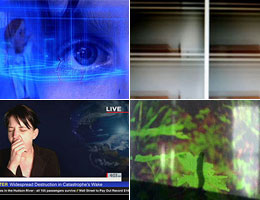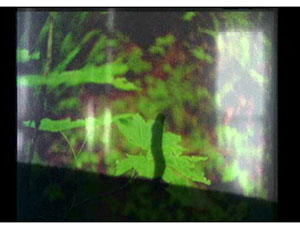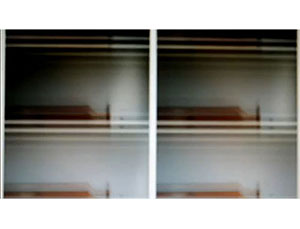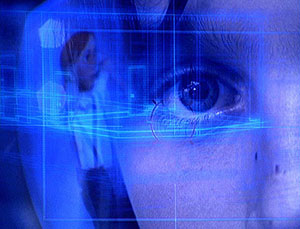BODY OF ANOTHER (show 3) — TRT: 29.21
What can be seen, behind our eyes.
[toggle title=”THE BROKEN NEWS SERIES: DISASTER (2012); Lori Felker; TRT: 5.00
This comes from an experiment/performance: an intimate attempt at reporting, mediating and being mediated.
Read more…” status=”progression_closed”]
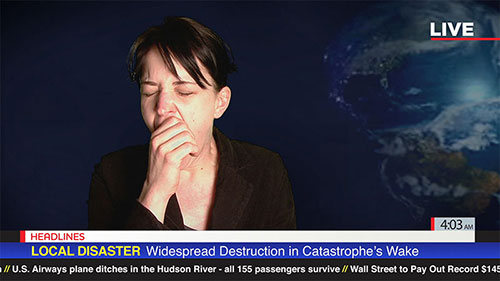
Your method seems to have a lot of humor to it, this is unusual in experimental films, how did this come about?
I like to call these videos “TV-shaped”. I’ve done four variations now: gardening, travel, teen science and the news. I plan to do more.
Humor exists in a natural, common, performative state, an area of human culture that seems to both define and challenge both groups and individuals on a daily basis. Humor is what we reach out for to feel human, to enjoy being human, to communicate something human as we play, interact, anticipate, wait, and realize. I hope that my work sets up situations that contain an intersection between satire, honesty, the uncanny and the nerve-wracking, where one might be able to find the relief of laughter, an audible connection with an audience, or be lost in a guffaw of disbelief.
What was your creative process?, do you write them first?
The Broken News Series (Disaster is part one), was written inside my brain while I slept, I suppose. I read the headlines over and over again each day recorded myself trying to recite them from memory before I went to bed, and then set my alarm to wake me up in the middle of a deep sleep. I had the green screen news station all ready at the foot of my bed. With the flick of a few switches, I would turn the station on, throw on a blazer and start to report the “news” still half asleep. I would just start with the first thing I could remember from my dreams, the rest just poured out naturally as it would if you were talking out your dreams to your partner just as you were waking. Some of the real news gets in there, too. In this first part, the disaster comes from the fact that I recorded this during the week of the 2010 Haitian earthquake. The graphics around me are a mix of fact, fiction, facts on the wrong dates, elaborations of my dreams and responses from my graphics collaborator, Chris Royalty.
[/toggle]
[toggle title=”MISSING GREEN; (2011); Joey Huertas aka Jane Public; Pixelvision & 16mm color negative; TRT: 9.39
Searching for a ghost. Erin Green, a college student, who has gone missing on account of her own clinical depression
Read more…” status=”progression_closed”]
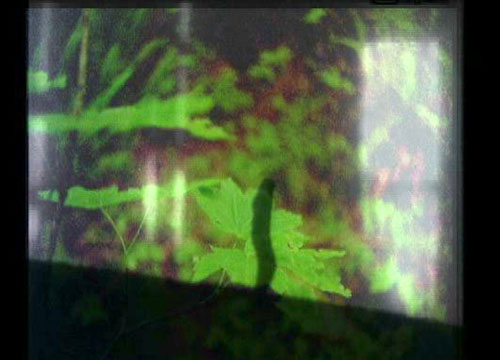
I was inspired to make ‘MISSING GREEN’ by a challenge I had made to myself: making a different type of film using extinct camera technology, and taking a deliberate departure from my usual kind of true-crime drama thing that I had been doing for years. I failed at the latter (thankfully). This film uses interview notes and images that I had gathered over the past year doing research on capital punishment across the U.S. and collaged into a notebook. This is the manner in how I usually make my films. I reviewed a notebook of collected glue-sticked images, police recorded phone interviews, police homicide division psychic research recordings, and notes – that is how I designed the dialogue, scenario and the story line for this film about, ‘Erin.’
The film uses PIXELVISION camera toy technology and analog sound tape recordings. I used the difficulty of translating old technology with new digital technology as the core of my creative process. Playing with these old toys resulted in unpredictable outcomes that had to be forced into responsible storytelling tools needed to tell this story of a young missing woman’s life.
[/toggle]
[toggle title=”2198 GHOSTS IN THE SUN, PEOPLE IN THE SEA; Yvette Granata; TRT: 3.20
Split-screen and vertical motion, and a series of 2,198 photographs taken in my deceased grandparents home in Abruzzo, Italy.
Read more…” status=”progression_closed”]

2198 GHOSTS IN THE SUN, PEOPLE IN THE SEA is a reorganization of day and night. Displayed in split-screen and vertical motion, the video travels through a series of 2,198 photographs taken in the house of my deceased grandparents in a small town in Abruzzo (Italy). Since their death many years ago, the house has remained empty. Positioned in front of ceilings and the corners of rooms, the camera is a surveillance of my position within the house and the changing light across the surfaces of the empty interior. It is a self-portrait through the re-organization of time and space.
[/toggle]
[toggle title=”TOXIC PARK; (2012); Cinzia Sarto & Emita Frigato; Digi; TRT: 11.22
Trapped in the Amusement Park, a child’s perceptions waver between illusion and reality.
Read more…” status=”progression_closed”]
A young girl stares at the transformation of her own reflection into a robotic Avatar until her final disappears.
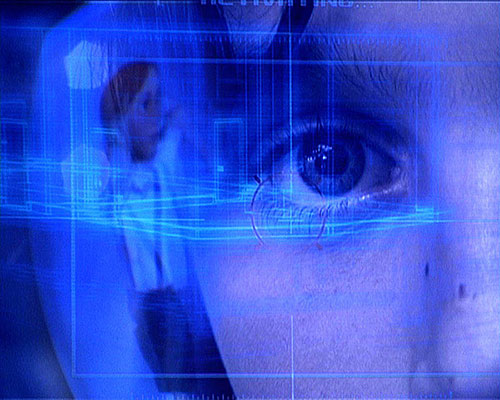
TOXIC PARK has great depth. What was your inspiration and how was this actually made?
The relationship between the body and its representation in our children own perception of themselves is the question we are investigating in this video. We chose the Amusement Park as an environment where playing is equal to economic profit and children like a parody of adults become clown-like consumers. Here plastic reproductions of nature, cartoonish translations of animals, children pharmaceutical advertisement and robotic infants are constructing the imaginary world of our new generations.
Social concerns abound in your films.
The video is an experiment where documentary materials shot at different amusement parks, documentation from the web, advertisements and other sources are joined together to create a consistent place. Here the abandonment of the body’s direct relationship with the material world, the future of the eyes captured by virtual reality, and the consequences of child medication are at play. The lullaby “who should I give this baby to?” sang by the girl in the car ride to the park in the beginning of the film will become our final question.
[/toggle]

